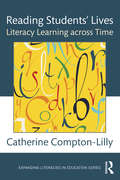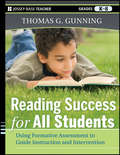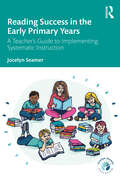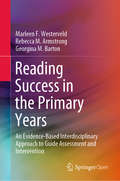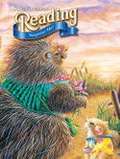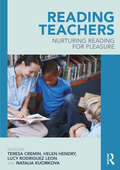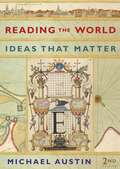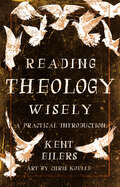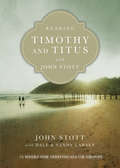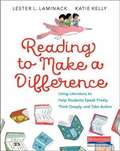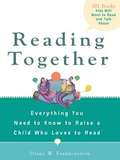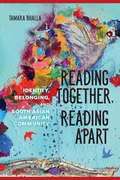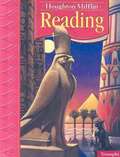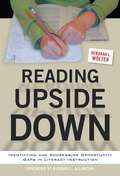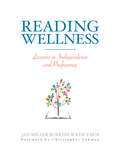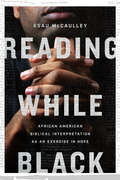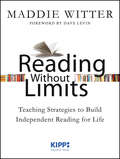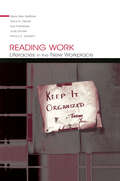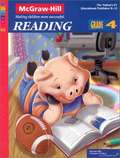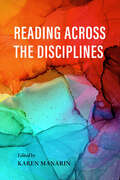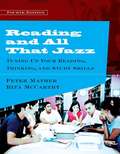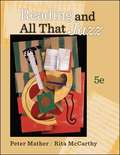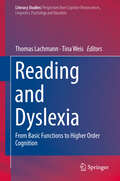- Table View
- List View
Reading Students' Lives: Literacy Learning across Time (Expanding Literacies in Education)
by Catherine Compton-LillyReading Students’ Lives documents literacy practices across time as children move through school, with a focus on issues of schooling, identity construction, and how students and their parents make sense of students’ lives across time. The final book in a series of four that track a group of low-income African American students and their parents across a decade, it follows the same children into high school, bringing to the forefront issues and insights that are invisible in shorter-term projects. This is a free-standing volume that breaks new ground both theoretically and methodologically and has important implications for children, schools, and educational research. Its significant contributions include the unique longitudinal nature of the study, the lens it casts on family literacy practices during high school years, the close and situated look at the experiences of children from communities that have been historically underserved by schools, and the factors that alltoooften cause many of these children to move further and further away from school, eventually dropping out or failing to graduate.
Reading Success for All Students
by Thomas G. GunningHelp for reading teachers in continuous monitoring, assessment and instruction that targets students' problem areas This vital resource offers classroom teachers and literacy coaches practical assessments that can be used to evaluate key areas in students' reading performance. These assessments will provide information that can be directly used for planning instruction. Specific instructional techniques and activities are linked to each of the assessments so that teachers know exactly how to teach necessary skills. Tests and other evaluative devices are aligned with Common Core State Standards and state frameworks. Offers a proven model for monitoring and assessing students Assessments and instructional strategies are easy to implement as part of any curriculum Practical strategies are modeled on a tested approach for helping students work through their problem areas
Reading Success in the Early Primary Years: A Teacher's Guide to Implementing Systematic Instruction
by Jocelyn SeamerReading Success in the Early Primary Years is a step-by-step guide to structured literacy instruction for teachers working in the early years of primary school. Written by a teacher, for teachers, this book supports teachers to understand the evidence base of reading instruction and how to successfully implement it. Structured in three parts, the book breaks down complex concepts in a concise, accessible manner, guiding teachers on eight key actions to take to get every child on the path to reading proficiency. These include instruction in phonics, phonological and phonemic awareness, integrated reading and spelling opportunities, and the use of decodable texts. Highly practical, Reading Success in the Early Primary Years offers over 20 explicit instructional routines that teachers can implement in their classrooms and guidance on how to get the most out of instructional time. These practical elements are further supported by a summary of relevant research and theories about how reading develops, including an outline of high impact, explicit teaching that draws on cognitive load theory. Rich with sample lesson plans, tools, and examples from real classrooms, this book allows teachers to get on with the business of teaching reading. This is a must-have resource for all who are responsible for children’s reading instruction in the first three years of school.
Reading Success in the Primary Years: An Evidence-Based Interdisciplinary Approach to Guide Assessment and Intervention (Springerbriefs In Education Ser.)
by Marleen F. Westerveld Rebecca M. Armstrong Georgina M. BartonThis open access book describes the Reading Success project, in which a 5-step, assessment-to- intervention process, based on the Simple View of Reading, was used within a primary school setting in Australia to better support those students who struggle with reading. It provides an easily accessible overview of each step of the process involved in implementing this approach and highlights the crucial importance of collaboration between professionals involved in the teaching of reading within a school setting. It focuses on the decision-making processes used, such as rich dialogue with the leadership team and teachers, and shares participants’ perspectives gathered throughout the project. Using case studies, the book describes how the 5-step approach assists in creating detailed profiles of students’ strengths and weaknesses in spoken and written language skills that can be used to guide targeted intervention This book offers valuable insights for educators, speech pathologists, researchers, and pre-service teacher education students interested in the teaching of reading
Reading Surprise Me! Level 1.6
by Scott ForesmanQuality literature, built-in skill instruction, and test preparation help every child become a successful reader who is prepared for state and national tests. The Grade 1 On-Level Readers provide six weeks of review for the skills previously covered in kindergarten.
Reading Teachers: Nurturing Reading for Pleasure
by Teresa Cremin Natalia Kucirkova Helen Hendry Lucy Rodriguez LeonThis engaging text offers primary school educators a principled way forward on their mission to nurture the life-changing habit of reading in childhood. Informed and inspiring, Reading Teachers accessibly demonstrates how teachers who are motivated, engaged and reflective readers themselves, can develop new understandings of reading for pleasure and make a difference to young learners. Drawing on a range of research evidence, including studies on reading teachers, dis/engaged boy readers, student teachers as readers and work with over 150 schools developing communities of readers, this book provides an accessible overview of international research alongside a highly practical classroom focus. Combining the insights of academics with 24 reading teachers in co-authored chapters, the book includes: • Case studies of how practitioners have used research to inform and improve their practice; • ‘In conversation’ dialogues between educators about classroom practice that fosters positive reader identities; • Reflections on the editors own reading habits, practices and histories; • Recommended reading and suggestions of engaging children’s books. Reading Teachers: Nurturing Reading for Pleasure enables practitioners to develop principled practice, helping all children find pleasure and purpose in reading. This book is therefore essential reading for all primary teachers, head teachers, literacy coordinators and trainee teachers.
Reading The World: Ideas That Matter (Second Edition)
by Michael AustinWestern and non-Western, classic and contemporary, longer and shorter, verbal and visual, accessible and challenging. With 72 readings by thinkers from around the world--Plato to Toni Morrison, Lao Tzu to Aung San Suu Kyi--Reading the World is the only great ideas reader for composition students that offers a truly global perspective. The Second Edition offers more contemporary readings and provides more help to make the texts accessible for undergraduate readers. Brief overviews of each reading give students a sense of what the piece is about, and detailed headnotes call attention to the rhetoric of each reading to help students focus not only on what the authors say but also on how they say it.
Reading Theology Wisely: A Practical Introduction
by Kent Eilers&“Could reading theology turn you toward God in astonished worship? Could it enliven your reading of Scripture? Could it move you toward your true self in Christ? Could it turn you toward your neighbors in self-giving love? Could it unmask your prejudices? Could it dethrone your idols? Should we hope for anything less?&” In this illuminating introduction, Kent Eilers invites Christians of all backgrounds into the practice of reading theology. With a classroom-tested approach, Eilers shows how theology can form the imagination and enhance &“the human capacity for perceiving reality beyond the surface of things&”—allowing Christians to see and experience God in the everyday. He then guides readers through the essential facets of theology so that it can begin to feel familiar and accessible, even (and especially) to beginners with no prior experience. Written conversationally and illustrated beautifully with art by Chris Koelle, Reading Theology Wisely is welcoming and engaging in every respect. Eilers takes a well-rounded approach to his subject, utilizing Scripture and the wisdom of past thinkers as well as references to film and the arts—including a special emphasis on architecture as part of an ongoing metaphor of &“inhabiting texts&” as we do physical spaces. Each chapter ends with a prayer and questions for reflection and discussion, followed by a &“theology lab&” in which readers can put the content of the preceding chapter into practice.
Reading Timothy and Titus with John Stott: 13 Weeks for Individuals or Groups (Reading the Bible with John Stott Series)
by John StottThe Message of Timothy & TitusThe Message of 2 Timothy
Reading To Make A Difference: Using Literature To Help Students Speak Freely, Think Deeply, And Take Action
by Lester L. Laminack Katie Kelly"This book is a gift to teachers who want to know how best to incorporate diverse literature into their classrooms. It translates rhetoric about diverse books into practical actions. Teachers will find it a valuable resource, full of examples of actual classroom practices and questions for reflecting, as well as suggestions of good books to share with students. It takes the study of diverse texts well beyond the "food, festivals and folklore" focus of the early days of attention to multicultural literature to a consideration of literature as a catalyst for social action. The thematic emphases for the chapters are broad enough to apply to texts that represent diverse cultures, but specific enough to work in diverse classrooms, from elementary school to the college level." - Rudine Sims Bishop, Professor Emerita of Education at The Ohio State University "In far too many schools, our effort to be more inclusive begins and ends with book selection. In Reading to Make a Difference, Lester and Katie teach us that this is not enough. This book is an urgent reminder that even the most powerfully diverse bookshelf cannot mask the damage done to children by practices and curriculum that fails to see them. Reading to Make a Difference shows us how to combine powerful books with purposeful, equitable practice." - Cornelius Minor Books as bridges enable readers to speak freely, think deeply, and take action. In Reading to Make a Difference, Lester and Katie build on the work of Rudine Sims Bishop, extending the notion of books as windows, mirrors, and doors. They offer a pathway that can lead students to take action for social justice causes. They show you how to move beyond exposing your students to diverse children's literature by offering an instructional framework that is applicable to any topic and can be adapted to your own classroom or community. Lester and Katie will show you how to: select and share text sets in a variety of reading experiences including read-aloud, small group, book clubs, and independent reading creating a scaffold for students to share their connections with a character, situation, issue, or topic invite students to pause and reflect provide opportunities for students to take action individually or collectively in a way that can make a difference. Each chapter highlights different classrooms in action and concludes with a wealth of suggested resources, both picture books and chapter books, along with helpful guidelines on how to choose text sets that reflect the needs, interests, and backgrounds of your students. The right book at the right time can open doors of possibility for a better world. Armed with an understanding of who your students are, where they come from, and what matters to them, you can cultivate children as thoughtful, caring citizens, and empower them to become lifelong agents of change.
Reading Together
by Diane FrankensteinA dynamic guide to more than 100 books that will get kids talking and reading more. How do children become good readers? In Reading Together, educational consultant Diane W. Frankenstein shares the secret: guiding children to find an appropriate book and talking with them about the story helps them connect with what they read. This engaging guide shares advice for parents, teachers, librarians, and caregivers on how to help children find what to read, and then through conversation, how to find meaning and pleasure in their reading. With more than 100 great book recommendations for kids from Pre-K through grade six, as well as related conversation starters, Reading Together offers a winning equation to turn children into lifelong readers. Some of the award-winning books discussed include Betty G. Birney?s World According to Humphrey, Gennifer Choldenko?s Notes from a Liar and Her Dog, and David Shannon?s Bad Case of Stripes. .
Reading Together, Reading Apart: Identity, Belonging, and South Asian American Community (The Asian American Experience)
by Tamara BhallaOften thought of as a solitary activity, the practice of reading can in fact encode the complex politics of community formation. Engagement with literary culture represents a particularly integral facet of identity formation--and serves as an expression of a sense of belonging--within the South Asian diaspora in the United States. Tamara Bhalla blends a case study with literary and textual analysis to illuminate this phenomenon. Her fascinating investigation considers institutions from literary reviews to the marketplace and social media and other technologies, as well as traditional forms of literary discussion like book clubs and academic criticism. Throughout, Bhalla questions how her subjects' circumstances, shared race and class, and desires limit the values they ascribe to reading. She also examines how ideology circulating around a body of literature or a self-selected, imagined community of readers shapes reading itself and influences South Asians' powerful, if contradictory, relationship with ideals of cultural authenticity.
Reading Triumphs
by J. David Cooper John J. Pikulski Houghton Mifflin Company StaffThis comprehensive intervention program supports those students reading two grade-levels below with intensive instruction focused on priority skills to accelerate instruction.
Reading Under Control: Teaching Reading in the Primary School
by Alison Kelly Judith GrahamNow in an updated third edition, this best-selling textbook introduces primary teachers to the key issues in how to teach reading. The authors celebrate reading as an important, exhilarating part of the curriculum with the potential to transform lives, whilst also giving a balanced handling of contentious issues. Strongly rooted in classroom practice, the book provides comprehensive coverage of differing reading practices and resources. Key features include: managing specialized reading difficulties, such as dyslexia EAL and gender issues in reading use of ICT within reading a detailed inspection of the phonics debate. This book is essential reading for both trainee teachers and qualified teachers interested in continuing their professional development.
Reading Upside Down: Identifying and Addressing Opportunity Gaps In Literacy Instruction
by Deborah L. WolterReading Upside Down offers a paradigm shift from achievement gaps to opportunity gaps in literacy instruction. Drawing on the author's rich experiences working one-on-one with challenged readers, this book presents case studies illustrating the complexities of student learning experiences and the unique circumstances that shaped their acquisition of literacy. Wolter explores eight key factors that contribute to reading challenges in developing readers, including school readiness, the use of prescribed phonics-based programs, physical hurdles, unfamiliarity with English, and special education labeling. With a focus on the differences that educators can make for individual students, the text suggests ways to identify and address early opportunity gaps that can impact students throughout their entire educational career.
Reading Wellness: Lessons in Independence and Proficiency
by Jan Burkins Kim YarisWith so many state standards and demands of accountability, it can be a challenge for teachers to teach in ways that create energy and enthusiasm for reading. In their book, Reading Wellness: Lessons in Independence and Proficiency , authors Dr. Jan Burkins and Kim Yaris want to reignite the passion in teachers and drive them to instill confidence, curiosity, and joy in students.Burkins and Yates define reading wellness to include all aspects of readership so we can be our best reading selves-. The book is built around a framework of four intentions: alignment, balance, sustainability, and joy. It includes a series of field-tested lessons that help children read closely and carefully while still honoring their interests, passions, and agency as readers.Reading Wellness encourages each teacher to shape these ideas in ways that support personal ideals and goals while nurturing a love of reading and a passion for lifelong learning.
Reading While Black: African American Biblical Interpretation as an Exercise in Hope
by Esau McCaulleyGrowing up in the American South, Esau McCaulley knew firsthand the ongoing struggle between despair and hope that marks the lives of some in the African American context. A key element in the fight for hope, he discovered, has long been the practice of Bible reading and interpretation that comes out of traditional Black churches. This ecclesial tradition is often disregarded or viewed with suspicion by much of the wider church and academy, but it has something vital to say. Reading While Black is a personal and scholarly testament to the power and hope of Black biblical interpretation. At a time in which some within the African American community are questioning the place of the Christian faith in the struggle for justice, New Testament scholar McCaulley argues that reading Scripture from the perspective of Black church tradition is invaluable for connecting with a rich faith history and addressing the urgent issues of our times. He advocates for a model of interpretation that involves an ongoing conversation between the collective Black experience and the Bible, in which the particular questions coming out of Black communities are given pride of place and the Bible is given space to respond by affirming, challenging, and, at times, reshaping Black concerns. McCaulley demonstrates this model with studies on how Scripture speaks to topics often overlooked by white interpreters, such as ethnicity, political protest, policing, and slavery. Ultimately McCaulley calls the church to a dynamic theological engagement with Scripture, in which Christians of diverse backgrounds dialogue with their own social location as well as the cultures of others. Reading While Black moves the conversation forward.
Reading Without Limits: Teaching Strategies to Build Independent Reading for Life
by Maddie WitterImagine a classroom where all students are engaged in highly rigorous and fun learning every single day. That classroom can be yours starting tomorrow. You don’t have to be a reading specialist to pick up this book. Anyone who wants to dramatically improve reading achievement will find helpful suggestions. You might be a third grade teacher whose students have mastered decoding, and you are ready to build their comprehension. Or you might be a high school science teacher whose students aren’t yet reading on level with deep critical thinking. This book is for you. It doesn’t matter whether you are a public, charter, private, or alternative education teacher: the Reading Without Limits program works in each one. Along with hundreds of ready-to-use teaching strategies, Reading Without Limits comes with a supplemental website where teachers can download even more resources for free! Reading Without Limits is the first book offered in the KIPP Educator Series. KIPP, or the Knowledge is Power Program, began in 1994. As of Fall 2012, there are 125 KIPP schools in 20 states and the District of Columbia serving nearly 40,000 students climbing the mountain to and through college.
Reading Wonderworks: Interactive Worktext Grade 4 (Reading Intervention Ser.)
by Douglas Fisher Timothy Shanahan Jan HasbrouckReseña del editor: The Interactive Worktext for grades 2-6 is a scaffolded version of the Reading Wonders Reading/Writing Workshop. It allows students to interact with complex texts through close reading by taking notes, marking text evidence, and writing responses in their own print or eBook version.
Reading Work: Literacies in the New Workplace
by Nancy S. Jackson Mary Ellen Belfiore Tracy A. Defoe Sue Folinsbee Judy HunterReading Work: Literacies in the New Workplace explores changing understandings of literacy and its place in contemporary workplace settings. It points to new questions and dilemmas to consider in planning and teaching workplace education. By taking a social perspective on literacies in the workplace, this book challenges traditional thinking about workplace literacy as functional skills, and enables readers to see the complexity of literacy practices and their embeddedness in culture, knowledge, and action. A mixture of ethnographic studies, analysis, and personal reflections makes these ideas accessible and relevant to a wide range of readers in the fields of adult literacy and language education and helps to bridge the divide between theory and practice in the field of workplace education.Reading Work: Literacies in the New Workplace features: *four distinct but related ethnographies of literacy use in contemporary workplaces;*a social practice view of literacy brought to the workplace;*collaborative research undertaken by experienced workplace educators and academics working in the areas of adult literacy and second language learning;*implications chapters for both practice and theory--presented not as a series of steps but rather as reflections by seasoned educators on shared dilemmas; and*engaging, accessible writing that encourages workplace practitioners to read, learn from, and do their own research.This book is an important resource for practicing workplace educators, trainers, and instructors; academics who teach workplace educators; unionists, policymakers, human resource managers, supervisors, or quality coordinators who believe education can make a difference and are interested in seeing maximum results from workplace learning. Visit the In-Sites Research Group Web site: http://www.nald.ca/insites/.
Reading Workbook (Grade #4)
by SpectrumSpectrum Reading grade 4 has engaging, lively passages in curriculum content areas. Recently updated to current national reading standards, including more nonfiction reading passages and activities. This book for children ages 9 to 10 contains proven instructional methods for developing reading proficiency. Reading skills include: ~Cause and effect ~Character analysis ~Reading comprehension ~Context practice ~Research skills Our best-selling Spectrum Reading series features grade-appropriate books for Preschool to 6. Developed with the latest standards-based teaching methods that provide targeted practice in reading fundamentals to ensure successful learning.
Reading across the Disciplines (Scholarship of Teaching and Learning)
by Rosemary Green Daniel Shapiro Pat Hutchings Margaret Mackey Angela Zito Heather C. Easterling Joyce Tang Boyland M. Soledad Caballero Yvonne Davila John Eliason Nelson Graff Neela Griffiths Rachel Henry Rebecca Kersnar Aimee Knupsky Ryne Leuzinger Elizabeth Marquis Trent W. Maurer Brett McCollum Layne A. Morsch Catelyn Shipp Dana Statton Thompson Kris Vasquez Jakob T. Zehms Jordan R. DonovanReading Across the Disciplines offers a collection of twelve essays detailing a range of approaches to dealing with students' reading needs at the college level. Transforming reading in higher education requires more than individual faculty members working on SoTL projects in their particular fields. Teachers need to consider reading across the disciplines. In this collection, authors from Australia and North America, teaching in a variety of disciplines, explore reading in undergraduate courses, doctoral seminars, and faculty development activities. By paying attention to the particular classroom and placing those observations in conversation with scholarly literature, they create new knowledge about reading in higher education from disciplinary and cross-disciplinary perspectives. Reading Across the Disciplines demonstrates how existing research about reading can be applied to specific classroom contexts, offering models for faculty members whose own research interests may lie elsewhere but who believe in the importance of reading.
Reading and All That Jazz (4th Edition)
by Peter Mather Rita MccarthyThis attractive, engaging introductory-to-intermediate reading text for undergraduates begins by introducing students to study skills and the college environment, with readings on learning styles, different types of intelligence, stress, and other areas that help students understand themselves as learners. The text then broadens the perspective to focus on interpersonal, social, national, and international issues, within sections on discovering meaning through structure, interpreting written material, recognizing modes of writing, reading critically, and getting ready for content-area classes.
Reading and All That Jazz (5th Edition)
by Peter Mather Rita MccarthyReading and All That Jazz, an introductory-to-intermediate reading text, motivates and engages readers with contemporary and relevant readings while building the essential reading skills and vocabulary needed for literal and critical comprehension. With multiple practice opportunities and an adaptive learning plan via Connect Reading, Reading and All That Jazz provides for genuine thinking, assessment, and interpretation.
Reading and Dyslexia: From Basic Functions To Higher Order Cognition (Literacy Studies #16)
by Thomas Lachmann Tina WeisIn this volume a group of well-known experts of the field cover topics ranging from basic visual and auditory information processing to higher order cognition in reading and dyslexia, from basic research to remediation approaches and from well-established theories to new hypotheses about reading acquisition and causes for its failure. Reading is one of the most intriguing feats human evolution ever came up with. There is no evolutionary basis for reading as such; reading is secondary to language and the result of a complex skill acquisition at the end of which almost all pre-existing cognitive functions are mobilized. With the right instruction and practice most people learn this skill smoothly. Some, however, have problems, despite same opportunities and general cognitive abilities. This developmental dyslexia results from a neuro developmental disorder leading to deficits in reading relevant information processing. But what deficits are these, and can they be trained?
